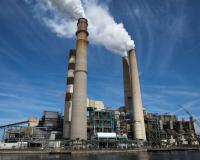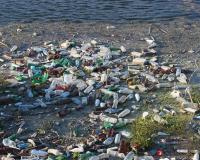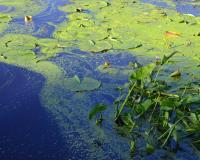
Vibrant Environment
Pollution Control
All | Biodiversity | Climate Change and Sustainability | Environmental Justice | Governance and Rule of Law | Land Use and Natural Resources | Oceans and Coasts | Pollution Control

When’s the last time you found yourself idly shopping out of boredom or buying a shirt just because it was on sale? If it was in the last week, then you’re not alone. The average American shopper buys 60% more clothing today than they did just 15 years ago, but keeps it for only half as long. At the end of the year, this results in approximately 80 pounds of unwanted clothing per person!

Frustrated by some states’ use of their Clean Water Act (CWA) §401 authority to oppose or delay energy projects—particularly the transportation of fossil fuels—the Trump Administration issued the second installment in its efforts to restrict that authority on June 7. The U.S. Environmental Protection Agency’s (EPA’s) Clean Water Act Section 401 Guidance for Federal Agencies, States and Authorized Tribes strictly interprets state deadlines under §401 and takes a narrow view of the grounds on which states may deny or condition their approval of projects. The guidance follows an April 10 executive order, and will be followed in August by proposed EPA rules, with final rules by May 2020.

Women have been leaders in every major movement, though their contributions all too often go unrecognized. The environmental movement is no exception. Women striving toward the betterment of this field have faced many challenges, but through skill and determination, they persevered. The environmental movement is over two centuries long with generations of women shaping policies and laws within the field. This blog features just a handful of the numerous women who paved the way for future environmentally conscious generations.

On April 12, 2019, the U.S. Court of Appeals for the Fifth Circuit vacated portions of the U.S. Environmental Protection Agency’s (EPA’s) 2015 Effluent Limitation Guidelines (ELGs) and Standards for the Steam Electric Power Generating Point Source Category (ELG Rule). ELGs are nationwide standards set by EPA to govern pollutant discharges from point sources.

The famous Cuyahoga River fire of June 22, 1969 — the spur that started debate on pollution across the nation, and led to passage of the Clean Water Act three years later — is lodged more in legendary storytelling than in reality. The fire was actually fairly minor, causing only $50,000 in losses to the Republic Steel Mill located along the river, damaging some wooden trestles. Moreover, no photograph of the event exists — the photo reproduced here, like the one a month later in Time magazine, was from a much larger 1952 blaze.

PFAS is a catch-all term for the chemical compounds per- and polyfluoroalkyls (including PFOA, PFOS, and replacements such as GenX). Seemingly overnight, these substances have gone from something talked about mainly by environmental lawyers and advocates to something that the public is increasingly focused on. The reasons for this shift include EPA’s and the states’ move to regulate these substances, recent lawsuits targeting PFAS manufacturers, and a better understanding of the way these substances may persist in the environment and harm human health. Because the future costs and obligations regarding the cleanup of, and human exposure to, PFAS are uncertain and likely significant, they present a challenge for environmental attorneys and their clients when performing deal diligence and negotiating contracts.

The world is waking up to the growing problem of plastic waste contaminating our ocean and terrestrial environments. Local governments—lauded as laboratories of innovation—have begun enacting bans and fees on single-use plastics, reducing the amount entering the waste stream in the first place. Businesses are stepping up; national and multinational governance bodies are adopting laws cutting down on the manufacture and distribution of single-use plastics. In the United States, California, the District of Columbia, Hawaii, and Maine have initiated statewide restrictions, while Oregon and Washington are considering similar measures.

Lack of access to safe wastewater management infrastructure and improved sanitation is a global challenge that affects over 2 billion people worldwide. While large-scale wastewater treatment plants are common throughout the world, off-grid communities that exist outside of areas covered by centralized water infrastructure are often geographically isolated or economically marginalized, making these services not only unaffordable but inaccessible. In the absence of these networks, many communities have chosen to adapt. Although it is typically considered to be unlawful or illegitimate by their national governments, communities have begun to build decentralized systems to treat and reuse wastewater for agricultural purposes.

March 16, 2019; a young whale is found washed up on a beach in the Philippines. Autopsy reveals the whale died from “gastric shock” after ingesting 40kg of plastic rubbish including plastic bags and other disposable plastic products. Three weeks later, a pregnant sperm whale is found dead on a beach in Sardinia, Italy, more than two-thirds of her stomach filled with plastic waste.
These whales are the latest casualties of a growing worldwide plastic pollution problem.

Widespread harmful algae bloom (HAB) outbreaks have profound negative impacts: threats to human health and safety, stress on ecological systems, diminished quality of life, and significant economic loss to water-based recreational and commercial activities. They occur due to decades worth of nitrogen and phosphorus nutrient runoff deposited into our freshwater lakes and water bodies. Now, excess nutrient runoff and human activity have contributed to an uncontrollable rise in HABs across the globe. This ongoing accumulation of nutrients into our shrinking freshwater supplies combined with warmer temperatures has turned these precious water bodies into petri dishes for harmful algae growth. Removing the overabundance of nutrients is essential to restoring these water bodies and preventing the growth of future HABs.